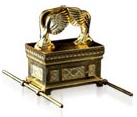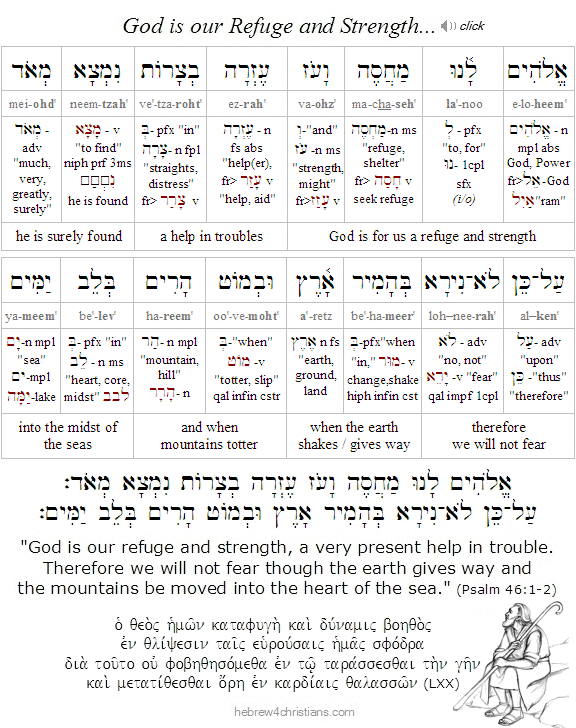|
In an effort to be thorough regarding the study of our last two Torah portions (Terumah and Tetzaveh), I thought it would be worthwhile to review a few other elements of the Tabernacle, or the Mishkan (מִשְׁכָּן). Of course there are a number of outstanding resources available for studying these matters in great detail, such as the Kleinman Edition of the Mishkan (available here) and the Mishkan Illuminated available from Judaica Press, both of which I recommend for further study.
For our purposes, however, I think it is worthwhile to remember that first of all the Mishkan was the product of a divine-human partnership. God asked for terumah (תְּרוּמָה), that is, a donation for the materials, and then He promised to manifest His Presence among the people. Moreover, when God instructed Moses to ask the people for a donation, He said they were to "take" (לָקַח) - not give - from their substance, because a gift made to the LORD is really a means of receiving great blessing in the world to come. The LORD said the donation was "for Me" (לִי), which the sages understood to mean "for my Name" (לִשְׁמִי). Of course God does not need anything since He is the Possessor of Heaven and Earth, but He extends to us the opportunity to sanctify His Name from our own substance. In other words, the LORD asked for "gifts from the heart" to create a "place" for Him: "Let them make for me a sanctuary that I may dwell in their midst" (Exod. 25:8). The Hebrew word for "sanctuary" is mikdash (מקְדָּשׁ), which comes from the root word kadash (קָדַשׁ), "to be set apart as sacred." A mikdash is therefore a "set apart space," or a "holy place" that represents something treasured - a place of beauty and worship, a refuge, a place of rest. The "material" required to make this place was ultimately the heart, expressed in freewill offerings given to God, and the blessing received would result in treasured peace and joy....
It should be noted that God required the Mishkan to be made exactly according to His specifications, since it was intended to reveal a hidden, spiritual reality that ultimately would be fulfilled in the ministry of Yeshua our Messiah. The Torah therfore repeatedly states that Moses should make all the elements precisely according to the pattern (תַּבְנִית) revealed to him at Sinai. "Exactly as I show you concerning the pattern of the tabernacle, and of all its furniture, so you shall make it" (Exod. 25:9, Heb. 8:5). A study of the Mishkan reveals the "blueprint" for God's redemption given through the atoning sacrifice of His Son, who served as our great High Priest after the order of Malki-Tzedek (מַלְכִּי־צֶדֶק). (For more information about the role of Yeshua as our High Priest, see the article "Yom Kippur and the Gospel.")
A note about measurements
Before we look at some of the elements of the Mishkan, we should be familiar with the measurement system commonly used to discuss it. Apparently the ancient Israelite system of measurement used the width of a finger (אֶצְבַּע) as its basic unit of measure. Four fingers wide, or a "handbreadth," is called a tefach (טֶפַח), which measures roughly 3.5" (8.9 cm). The plural of tefach is tefachim (טְפָחִים). Now six tefachim, or "hands," is called an amah (אַמָּה), which measures roughly 21" (an amah is sometimes called a "cubit"). The plural of amah is amot (אַמּוֹת).
- Etzbah (אֶצְבַּע) - a fingerbreadth; roughly .875" (plural is etzba'ot)
- Tefach (טֶפַח) - a handbreadth; roughly 3.5" (plural is tefachim)
- Amah (אַמָּה) - six handbreadths (i.e., "cubit"); roughly 21" (plural is amot)
Overview of the Tabernacle
The Mishkan would consist of two main parts: a tent-like structure called the ohel (אהֶל) and an outer court called the chotzer (חָצֵר). The tent was 30 amot long (52.5') and 10 amot wide (17.5') and was to be divided into two separate chambers. The innermost chamber was called the "Most Holy place" (קדֶשׁ הַקֳּדָשִׁים), measuring 10x10 amot, that would enclose the Ark of the Testimony (אֲרוֹן הָעֵדֻת). The Most Holy place was to be separated from an adjoining chamber (called the "Holy place") by means of an intricately woven curtain called the parochet. The Holy place was divided into two regions. In the region closest to the parochet were to be placed three special furnishings: a table of "showbread" (שֻׁלְחָן), a menorah (מְנוֹרָה), and an altar of incense (מִזְבַּח הַקְּטרֶת). The altar of incense (often called the Golden Altar) occupied the exact center of the Holy place. The outer court of the Mishkan measured 100 amot long (175') by 50 amot wide (87.5'). On the east side of the courtyard, 30 amot from the entrance, a copper altar was to be used for daily sacrifices. In addition, a copper water basin was to be used by the priests after performing their ministrations. The outer court was to be surrounded by a series of interconnecting posts held in place by silver sockets, from which curtains of blue, purple, and scarlet linen were to be hung. Here is a very simplified diagram of the layout:
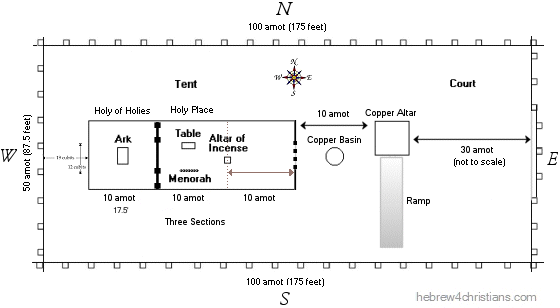 |
The Holy of Holies (קדֶשׁ הַקֳּדָשִׁים)
The Holy Ark (אֲרוֹן־הַקּדֶשׁ)
The first element of the Mishkan was a chest or "ark" (i.e., aron: אֲרוֹן) that is described in Exodus 25:10-22. The ark was essentially a wooden box measuring 2.5 amot in length (i.e., 52.5") and 1.5 amot in width and height (31.5"). This wooden box was covered by another (larger) box, made of pure gold, that surrounded it, and the inside of wooden box contained a (smaller) gold box that covered the inside. In other words, the ark was composed of three separate (and overlapping) boxes: a wooden box covered by a gold box with another gold box inside. The outermost box also had a border (or "diadem") called a zer (זֵר) that would hold the cover (kapporet) in place (Exod. 25:11). Four rings of gold were placed on the upper corners of the outer box, used for two gold-covered carrying poles (Exod. 24:14).
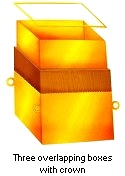
Interestingly, unlike the other furnishings of the Mishkan, the poles of the ark were never to be removed, and the ends of the poles were therefore made thicker than the width of the rings (Yoma 72a). The exact length of the poles of the ark is unknown. When the ark was carried, the poles rested on the shoulders of the Levites.
The ark was the holiest object of the Mishkan and a symbol of kisei ha-kavod (כִּסֵּא הַכָּבוֹד), the Throne of Glory. It was the only furnishing placed in the Holy of Holies (קדֶשׁ הַקֳּדָשִׁים). Inside the ark were placed the two tablets (i.e., the luchot) and the Sefer Habrit (the scroll containing the mishpatim that was ratified by the elders of Israel at Sinai). Jewish tradition also says that an additional scroll containing the 70 Names of God was also placed within the ark (Baal Haturim). A wooden copy of the Ark (sometimes called the "war ark") was later taken into battle by the war priests (Deut. 10:1).
The Kapporet (כַּפּרֶת)
Upon the ark was placed the kapporet, a cover of pure gold (sometimes called the "Mercy Seat") upon which were to be fashioned two cherubim (i.e., angel-like figures) that would face one another (Exod. 25:17-18). The kapporet rested upon the top walls of the ark - just inside the outer box - and was held in place by the crown (or border) of the ark. The cherubim were made from the same piece of gold as the kapporet. According to the Talmud (Succah 5b), the cherubim resembled children - one boy and one girl - and measured ten tefachim to the top of their heads (i.e., 35"). The wings of the cherubim were spread upward, over their heads, covering most of the cover, while their eyes gazed upon the ark (Exod. 25:20). From between the outstretched wings of the cherubim God would appear to reveal additional Torah (Exod. 25:22). God's Word would descend from heaven to the space between the cherubim, where Moses would be able to hear it at the appointed time.
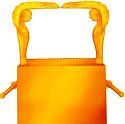
The Holy Place (הַקּדֶש)
Three sacred objects were to be placed within the Holy Place (הַקּדֶשׁ) of the Tabernacle: the Table that held the "bread of faces" (Exod. 25:23-30), the Menorah (Exod. 25:31-40), and the Golden Altar of Incense (Exod. 30:1-10). It is worth noting that although the Holy Place was an area of the tent intended for the priests to serve, non-Levites could come into this area of the Tabernacle on occasion, and some were even honored with lighting the menorah on special occasions.
The Table (שֻׁלְחָן)

The table held the bread that was to be ritually eaten by the priests as they served in the tabernacle (Exod. 25:30). The root word of shulchan (table) is shalach (שׁלח), meaning "to send," and is therefore symbolic of God's provision for his people. We eat food at our tables in order to be "sent" into the world in service to the LORD. A midrash stated that any priest who ate a portion of the lechem ha-panim (the bread of presence) the size of a bean was completely satisfied.
The table itself was made out of acacia wood covered with pure gold. The table top was 1 tefach thick (3.5") with a supporting frame that had a diadem or crown (Exod. 25:24-25). The four legs were attached to the frame (though some say that frame appeared above the top, like a tray, and therefore the legs were attached directly to the top). The table measured 2 amot in length (42"), 1.5 amot high (31.5"), and 1 amah wide (21"). Like the ark, two gold-covered poles were used to carry the table, though these were apparently removed when the table sat in the Holy Place.
Included with the table were golden "bread molds," spoons, and a supporting frame that would hold the loaves of (unleavened) bread (Exod. 25:29). According to Rashi, the bread itself was called lechem ha-panim (lit., "the bread of faces") because the two "faces" (or ends) of the loaves were to face the sides of the sanctuary. The bread loaves looked a little like open boxes:
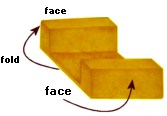
The twelve loaves of bread were made of matzah from pure wheat (Lev. 24:5-6) and were "stacked" upon one another in two columns of six loaves. Each loaf measured 5 tefachim wide (17.5"), six tefachim long (21"), and two tefachim high (7"). The base of the bread was thin, just a fingersbreadth. According to the Talmud, the tops of the loaves had grooves that held golden "half tubes" (shaped like a straw that was split down the middle) that were used to stack the loaves atop one another. These half tubes would function as a sort of "tray" that would connect to a supporting "scaffold" attached to both sides of the table. The half tubes and the supports created a frame for the bread to be placed on the table:
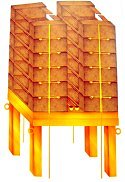
In addition to the bread molds, two spoons were made, one for each stack, that had flat bottoms (like a measuring cup), that were used for incense for the table (Lev. 24:7). The lechem ha-panim was baked on Friday and placed on the table on Shabbat (Lev. 24:8).
The Menorah (מְנוֹרָה)
The menorah (מְנוֹרָה) was formed from one piece of pure beaten gold weighing 3,000 shekels of silver (nearly 100 pounds). It was a highly decorative work that had seven branches (with seven lamps), nine flower blooms, eleven fruits, and twenty two cups. According to the Talmud, the menorah measured eighteen tefachim (i.e., "palms") in height (from the base to the start of the lamps), or roughly 5.25 feet. It is called the "lamp of God" (נֵר אֱלהִים) in the Scriptures (1 Sam. 3:3).
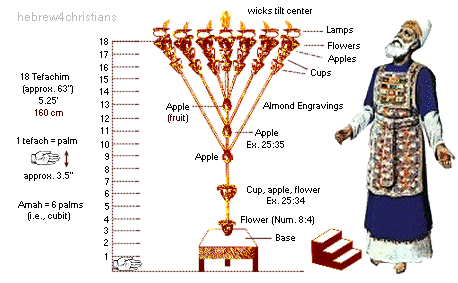 |
The "lamp of God" was to be made by hammering a single piece of solid gold into shape (Exod. 25:36). Note that the word translated "hammered" or "beaten" (מִקְשָׁה) comes from the word for "difficult" in Hebrew (קָשֶׁה). According to midrash, the method for constructing the menorah was difficult for Moses to comprehend, so the LORD first showed him one in the fire and told him: "This is how you will make it." Moses was unable to do so, however, so the LORD told him to take a block of gold and have Betzalel (the carpenter from Judah) throw it into the fire. After a flash of dazzling light, a menorah came out formed by God Himself. (For more information about the Menorah, see "A Closer Look at the Menorah.")
The Altar of Incense (מִזְבֵּחַ הַקְּטרֶת)
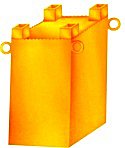
The golden altar (mizbe'ach ha-zahav) was the last item that was to be placed in the Holy Place of the Mishkan. It is described later in the Torah, however, after the description of the outer court, the copper altar, the copper basin, and so on. According to midrash, when the Mishkan was completed and the sacrifices were finally offered upon the copper altar, the Shekhinah did not descend until the ketoret (incense) was offered upon the altar within the Holy place (Tanchuna Tetzaveh).
The Golden Altar, or "Altar of Incense," was made out of wood and covered entirely with pure gold. It measured 2 amot in height (42"), and was 1 amah in both length and width (21"). The top of the altar included four corner pieces that measured 1 tefach (i.e., a 3.5" square). The altar also included a "crown" or border like the Ark and the Table. Like the other furnishings in the Mishkan, rings were attached for carrying poles (though these were apparently removed when it was placed in the Holy Place). The purpose of the altar was to burn ketoret upon its roof, or top surface (Exod. 30:1). In addition, blood was sprinkled upon its corner pieces during Yom Kippur and other occasions (Exod. 30:10). The location of the altar was exactly in the center of the Holy Place (Yoma 33a). As such, the altar symbolized the centrality of prayer and sacrifice before the Throne of God.
Messiah in the Tabernacle
The Mishkan can be seen to prefigure the ministry of Yeshua the Messiah in various ways. For instance, the three-colored gate of the outer court faced east, toward the tribe of Judah (Exod. 27:9-19, Num. 2:3), which served as the only entrance to the Tabernacle itself (the connection with Judah has to do with Shiloh, the promised redeemer and Messiah of Israel). Likewise Yeshua identified Himself as the Gate and the point of entry to the Presence of God (John 10:7-9; 14:6). The Copper Altar (Exod. 27:1-8) was the first object visible in the outer court and represented the various offerings that were given to God, including the daily (tamid) offering of a yearling lamb with wine and unleavened bread. Yeshua can be seen as the fulfillment of the various offerings represented by His finished work upon the cross for our salvation as the Lamb of God.
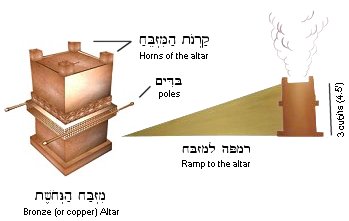
Washing in the Copper Basin (Exod. 30:17-21), or kiyyor, was the means by which access to the Holy Place was granted, and may represent cleansing, teshuvah, or baptism (mikveh).
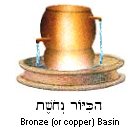
The tent itself (ohel) was divided into three geometric sections, the Holy Place (2 parts) and the Holy of Holies (1 part). Within the Holy Place were three furnishings: the Altar of Incense, the Menorah, and the Table of showbread. The Altar of Incense (Exod. 30:1-8) was the central object of the Holy Place, situated directly in front of the parochet (or curtain) that separated the Ark of the Covenant from the Holy Place. The incense represented the "aroma" or fragrance of prayer and sacrifice in service to God (see Rev. 8:3-5; Heb. 7:25). The Menorah (Exod. 25:31-39) represented the Divine Light and was the only source of light in the Tabernacle itself. The central branch of the Menorah (shamash) was called the "westernmost" lamp because it faced the Ark of the Covenant. Unlike the other lamps, the westernmost lamp burned continuously and therefore represented the Eternal Light (John 1:4; 8:12). The table (shulchan) held the Bread of Presence which represented the manna and God's provision for His people (John 6:33-35). The veil (parochet) separating the Holy Place from the Holy of Holies is likened to the body of Yeshua that was broken for us (Heb. 10:20; Matt. 27:51; Heb. 9:20; 10:10,12,14). The Ark of the Covenant, and in particular the Mercy Seat (kapporet) represented the Throne of God (Heb. 4:16; 2 Ki. 19:15) where propitiation for our sins was made (Rom. 3:25).
A few other quick comments in this connection. Yeshua is said to have "tabernacled" with us, thereby implying the connection between His ministry and the redemptive program of the Mishkan (John 1:14). The Mishkan and its furnishings were created by Betzalel, a young man filled with the Ruach HaKodesh from the tribe of Judah who was described using the same attributes as the Creator of the Universe (Exod. 35:31; Prov. 3:19-20). According to the Talmud, Betzalel was just 13 years old when he began building the Tabernacle. As a young man chosen by God Himself, Betzalel "came and healed the wound" that was caused by the sin of the Golden Calf (Shemot Rabbah), which likewise prefigures healing from the consequences of the original sin. The High Priest (kohen gadol) and his garments likewise are richly symbolic of the ministry of Yeshua, including the elaborate ordination process that required the anointing (mashach) of oil and the application of sacrificial blood to upon the priest's hands, feet, and forehead. The clothing also suggests an imputed righteousness that allowed access into the Divine Presence by God's grace... Of course, the author of the Book of Hebrews makes many more comparisons and distinctions between the Levitical priesthood and the greater priesthood of Yeshua, especially in light of the symbolism associated with Malki-Tzedek.
Unfortunately I do not have time to go into the rest of the fascinating furnishings of the Mishkan at this time, so this will have to suffice for now.... If God wills, I will continue this survey at a later time. Shalom chaverim.
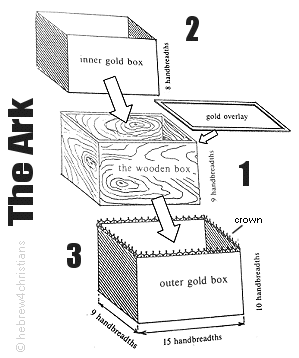 |
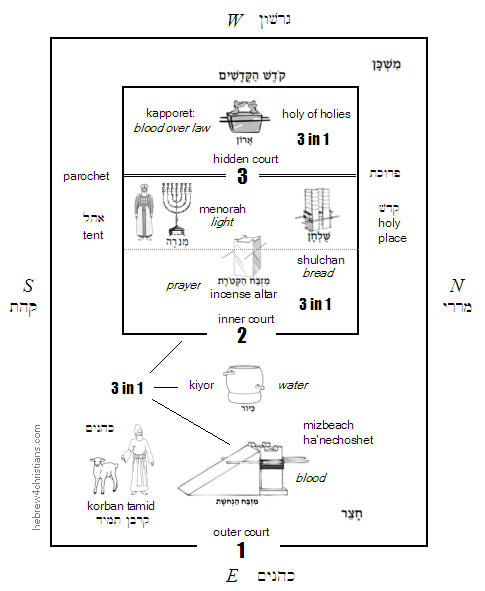 |
Hebrew Lesson
Psalm 46:1-2 reading (click for audio):
|


